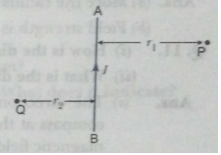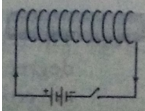Short Answer Questions - I - 2 Marks
Que 1. Identify the poles of the magnet in the figure (a) and (b) shown below.

Ans. The magnetic field lines emerge from north pole and merge at the south pole.

Que 2. The given magnet is divided into three parts A, B and C.
|
A |
B |
C |
Name the parts where the strength of the magnetic field is:
(i) maximum (ii) minimum
How will density of magnetic field lines differ at these parts.
Ans. (i) Maximum magnetic field is in the region A and C.
(ii) Minimum magnetic field is in the region B.
Reason: A and C are magnetic poles and have maximum number of magnetic field lines which determine the intensity of magnetic field while B is centre of the magnet has no magnetic field lines. So intensity of magnetic field near B is almost zero.
Que 3. AB is a current-carrying conductor in the plane of the paper as shown in figure. What are the directions of magnetic fields produced by it at points P and Q? Given r1 > r2, where will the strength of the magnetic field be larger?

Ans. Magnetic field at P is into the plane of paper and at Q it is out of the plane of paper. The strength of the magnetic field at Q will be larger as strength of the field 
Que 4. What is electromagnetic induction?
Ans. Whenever the magnetic flux linked with a circuit changes, an induced e.m.f. (electromotive force) and hence induced current is produced in the circuit. This phenomenon is known as electromagnetic induction and is used to generate electric current in a generator or a dynamo.
Que 5. Write SI unit of magnetic field. Under what condition does a moving charge experience
(i) maximum force (ii) minimum force?
Ans. The SI unit of magnetic field is tesla.
(i) Maximum force: When the velocity of charge and the magnetic field are perpendicular to each other.
(ii) Minimum force: When this charge is moving in the direction of the magnetic field.
Que 6. What is an electromagnet? Draw a circuit diagram to show how a soft iron piece can be transformed into an electromagnet.

Ans. The magnetic field produced due to current flowing in a coil or a solenoid can be used to magnetise a material like soft iron temporarily. The insulated copper wire is warpped on a soft iron piece. When current is passed through the coil using a battery and a key the iron piece behaves like a bar magnet as long as current is being passed. Such a magnet is called an electromagnet.
Que 7. A magnetic compass shows a deflection when placed near a current-carrying wire. How will the deflection of the compass get affected if the current in the wire is increased? Support your answer with a reason.
Ans. In the current in the wire is increased, the deflection increases. The strength of magnetic field is directly proportional to the magnitude of current passing through the straight conductor.
Que 8. What does the divergence of magnetic field lines near the ends of a current-carrying straight solenoid indicate?
Ans. The divergence, that is, the falling degree of closeness of magnetic field lines indicates the fall in strength of magnetic field near and beyond the ends of the solenoid.
Que 9. A student performs an experiment to study the magnetic effect of current around a current carrying straight conductor with the help of a magnetic compass. He reports that
(i) the degree of deflection of the magnetic compass increases when the compass is moved away from the conductor.
(ii) the degree of deflection of the magnetic compass increases when the current through the conductor is increased.
Which of the above observations of the student appears to be wrong and why?
Ans. The first observation is wrong. Because as the distance from the conductor increases, the strength of the magnetic field will decrease. So the degree of deflection of the compass should decrease instead of increasing.
Que 10. How does the strength of the Magnetic field at the centre of a circular coil of a wire depend on: (a) radius of the coil (b) number of turns in the coil.
Ans. (a) More the radius weaker the field.
(b) Field strength is directly proportional to the number of turns in the coil.
Que 11. (i) How is the direction of magnetic field at a point determined?
(ii) What is the direction of magnetic field at the centre of a current- carrying circular loop?
Ans. (i) The direction of the magnetic field at a point can be found by placing a small magnetic compass at that point. The north end of the needle of a compass indicates the direction of magnetic field at a point where it is placed.
(ii) The direction of magnetic field at the centre of a current-carrying circular loop is perpendicular to the plane of the loop.

